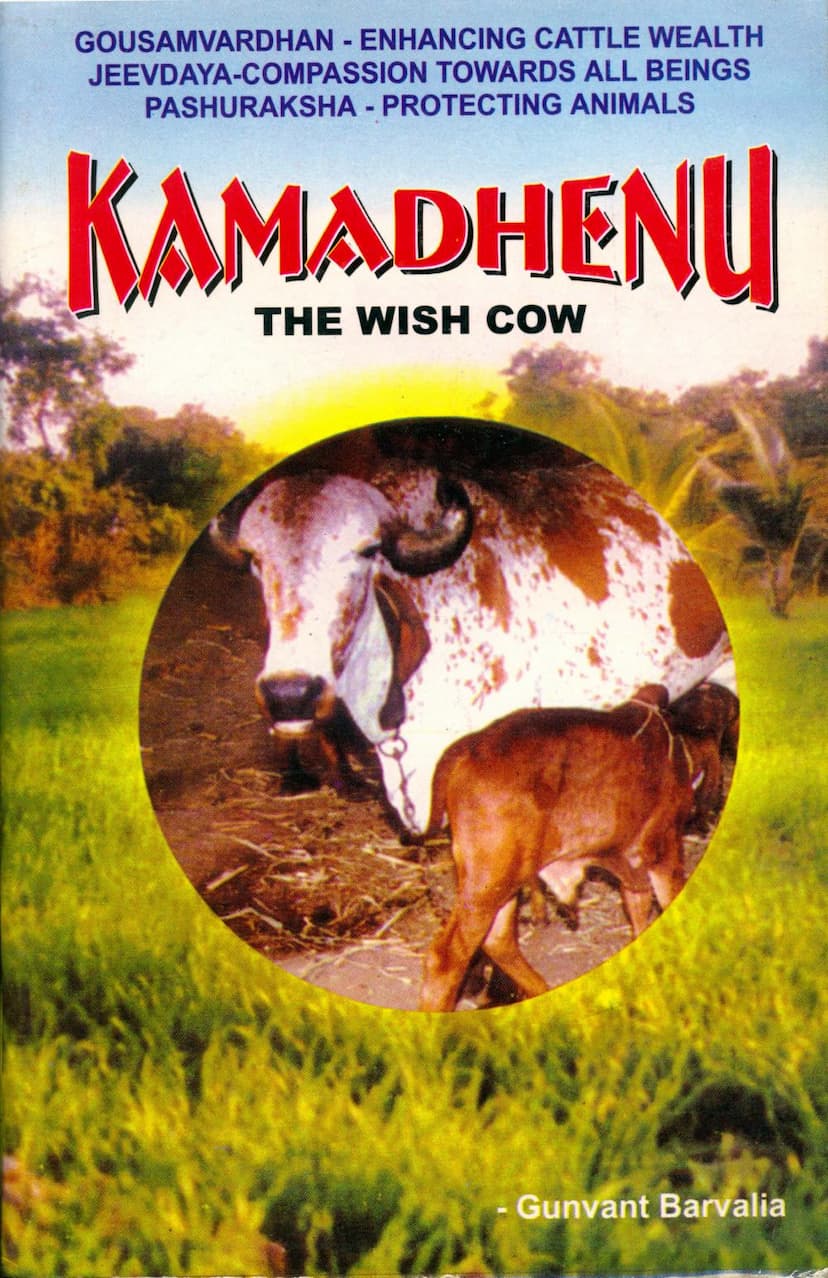Kamdhenu The Wish Cow
Added to library: September 2, 2025

Summary
Here's a comprehensive summary of the Jain text "Kamdhenu: The Wish Cow" by Gunvant Barvalia, based on the provided pages:
Central Theme: The Profound and Multifaceted Value of the Cow
The book "Kamdhenu: The Wish Cow" extols the immense and often overlooked value of the cow, not just as a source of milk, but as a cornerstone of Indian civilization, spirituality, economy, ecology, and overall well-being. It argues that the cow is more than a milch cow; it is a "Wish Cow" that bestows numerous benefits and is intrinsically linked to human and planetary welfare. The text advocates for a profound reverence and dedicated protection of cattle wealth, rooted in ancient Indian traditions and supported by modern scientific understanding.
Key Aspects and Arguments Presented:
-
Divine and Cultural Significance:
- The cow is revered as divine, a mother figure, and even the mother of the universe, as stated in ancient scriptures.
- Historical and religious narratives, from King Dilip's devotion to Maharshi Chyavan's valuation, highlight the cow's central role and esteemed status in Indian culture.
- The cow's welfare is presented as intrinsically linked to the preservation of Indian culture and civilization.
-
Economic and Agricultural Importance:
- Cows are fundamental to India's agrarian economy. Their products (milk, ghee, dung) and labor (bullocks for plowing and transport) are essential for agriculture, rural livelihoods, and national prosperity.
- Cow dung is described as a valuable resource, a "gold mine" used for fuel, fertilizer, construction, and even has medicinal properties. Cow urine is highlighted for its antibacterial qualities and use in agriculture and medicine.
- The text criticizes modern economic models that disregard the cow, leading to the decline of agriculture and rural economies.
-
Health and Medicinal Properties:
- Cow's milk is portrayed as nectar, possessing numerous health benefits, including aiding digestion, enhancing intellect, and being a source of vital nutrients.
- Various traditional Ayurvedic remedies utilizing cow's milk, ghee, dung, and urine are detailed for treating a wide range of ailments, from acidity and eye problems to tuberculosis and snake bites.
- The book emphasizes the antibacterial properties of cow urine and its potential as a bioenhancer, even obtaining a US patent for a composition involving cow urine distillate and antibiotics.
-
Ecological Harmony and Sustainability:
- The text strongly advocates for organic farming ("Ahimsak Kheti") and the use of cow dung and urine as natural fertilizers, contrasting it with the harmful effects of chemical fertilizers and pesticides.
- Grazing pastures are identified as the lifeline of cattle wealth and crucial for ecological balance. The destruction of these pastures due to development and encroachment is decried.
- The concept of "Dung Economy" and "Cow-Dung Culture" is promoted as a sustainable model for development.
-
Critique of Modern Practices and Policies:
- The book heavily criticizes policies that lead to the slaughter of cows, the import of milk powder, cross-breeding with foreign breeds, and the neglect of native breeds.
- It condemns the "mechanical economy" of the West for its inherent violence, consumerism, and disregard for natural resources, particularly its view of animals as mere commodities.
- The text expresses dismay at government policies that favor the meat industry over cattle welfare and advocates for the complete ban on cow slaughter.
- The establishment of slaughterhouses in rural areas and the focus on meat export are seen as detrimental to Indian culture and economy.
-
The Role of NGOs and Public Advocacy:
- The book highlights the efforts of various NGOs like the Ahimsa Research Foundation, Viniyog Parivar, and Govigyan Bharati in promoting Ahimsa, Jeevdaya (compassion for all beings), and cow protection.
- It documents their successful campaigns against detrimental policies, such as opposing the removal of the ban on beef export and the establishment of slaughterhouses.
-
Jain Philosophy and Ahimsa:
- The text frequently references Jain principles, particularly Bhagawan Mahaveer's teachings on Ahimsa (non-violence), Anekantvada (plurality of viewpoints), and detachment.
- It connects the Jain emphasis on compassion and non-violence to the protection of cows and all living beings.
- The book draws parallels between the sacrifices and teachings of Jain saints and the broader Indian tradition of venerating the cow.
-
The Concept of Charity (Dana):
- Charity is presented as a vital virtue in Indian culture, emphasizing selfless giving, reducing attachment, and fostering compassion.
- Donating cows is highlighted as a significant act of charity with immense spiritual merit.
- The importance of ensuring the proper utilization of charitable funds and promoting self-sufficiency among beneficiaries is stressed.
-
Specific Examples and Anecdotes:
- The book includes numerous historical and mythological references, such as King Dilip serving Nandini, Maharshi Chyavan's valuation, Satyakam Jabal's service, and the devotion of saints like Apadana and Apagiga.
- It narrates the story of Maharaja Shri Krishnakumar Sinhji of Bhavnagar, who contributed significantly to the establishment of Gir and Kankrej breeds in Brazil, earning him posthumous honor.
- The critical analysis of the 10th Five Year Plan's suggestions regarding the meat industry and the impact of NGOs in reversing these recommendations are presented.
Conclusion:
"Kamdhenu: The Wish Cow" is a passionate treatise advocating for the resurgence of cow worship and protection in India. It urges readers to recognize the cow's multifaceted importance and to actively participate in its preservation, viewing it not just as an animal but as a sacred, vital component of human existence and a symbol of a pure, sustainable, and compassionate way of life. The book calls for a holistic approach that integrates traditional wisdom with modern scientific understanding to safeguard this invaluable asset for present and future generations.